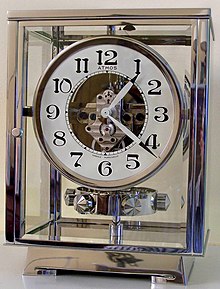Atmos
The Atmos ( atmospheric clock ) is a table clock model from the watch manufacturer Jaeger-LeCoultre . It gets its drive energy from the temperature and air pressure dependent volume changes of the gas chloroethane , which is in the pressurized can. The energy gained is stored in a mechanical spring. According to the manufacturer, a temperature difference of 1 Kelvin is sufficient to wind the watch for about 48 hours.
The Beverly Clock in the elevator foyer of the Physics Institute at the University of Otago in Dunedin , New Zealand, has a similar mechanism .
Because of the low energy that can be achieved, a torsion pendulum made of the metal alloy Elinvar with a half - oscillation period of 30 seconds is used; the mechanical movement has few parts that do not require oil lubrication. Due to the low energy available, there are no Atmos with seconds hands or with a bell. On the other hand, because of the slow rotation, it is not a problem to operate a display of the moon phases, as is built into some Atmos models.
Also because of the low drive energy, any dust particle would disrupt the process or bring it to a standstill. The works are therefore always glazed. The average accuracy that can be achieved is specified with a deviation of about one minute per month, carefully regulated copies should deviate by less than 30 seconds. In previous years, the manufacturer recommended that an overhaul should be carried out at the latest after 20 years. The expected lifespan was given as "several hundred" years.
The watch was invented by the Swiss engineer Jean-Léon Reutter around 1928. The first drafts still worked with the expansion of a mercury column . In the 1930s, the Swiss watch manufacturer Jaeger-LeCoultre took over the design, had the watch patented and has been building it in series ever since.
One of the first atmospheric clocks was the Cox clock , which was built by James Cox and Jean-Joseph Merlin in the 1760s and issued by Cox as a perpetual motion machine .
Web links
Individual evidence
- ^ Catherine Pagani: Eastern magnificence & European ingenuity: Clocks of Late Imperial China . University of Michigan Press 2001, ISBN 0472112082 , p. 100 ( excerpt from Google book search)
- ^ Arthur WJG Ord-Hume: Perpetual Motion: The History of an Obsession . Adventures Unlimited Press 2006, ISBN 1931882517 , pp. 110–124 ( excerpt from Google book search)
